Ringtail Posse 8: September 2023 - Saving Sydney's Last Koalas
Logging Now Stopped In Future Koala Park By Minns Government - ''Is There Time To Save Sydney's Last Koalas Too?'' Asks: John Illingsworth, WIRES, Sydney Wildlife Rescue, Save Sydney Koalas, The Sydney Basin Koala Network, The Help Save The Wildlife & Bushlands In Campbelltown Group, Appin Koalas Animal Rescue Service, Patricia & barry Durham, Sue Gay, Save Mt. Gilead, Paola Torti Of The International Koala Intervention Group
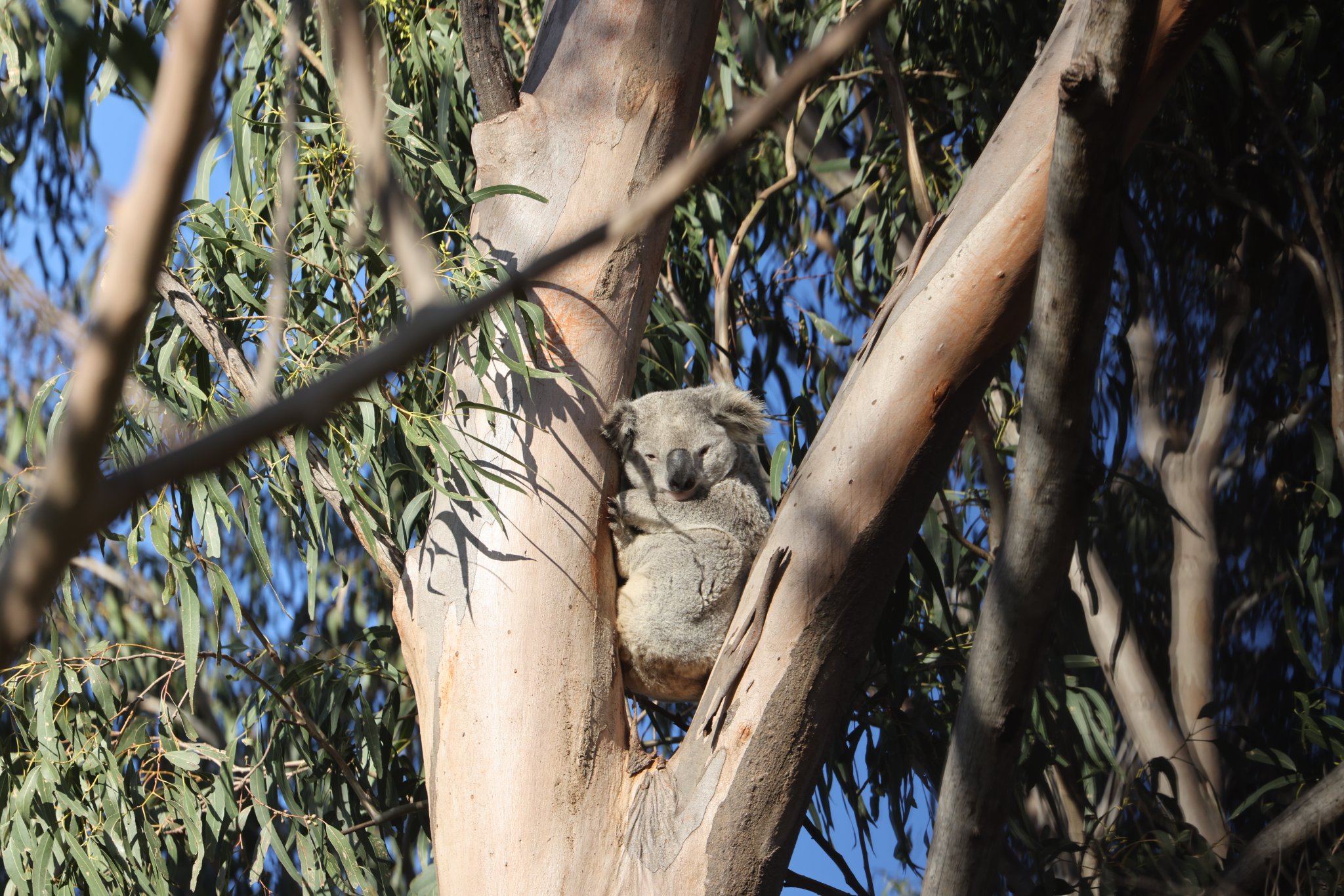
Campbelltown Koala. Photo courtesy Patricia Durman, taken August 2022
Posted Friday September 15, 2023. Ricardo Lonza; ''He has now been rescued and is in care''
Posted September 13, 2023 at 17:38.
Definition from:
Ringtail: from the 'Common Ringtail Possum' which is not so common anymore in urban areas. The Common Ringtail Possum is found along the entire eastern part of Australia and south west Western Australia. They are also found throughout Tasmania. The western ringtail possum is a threatened species under State and Commonwealth legislation. In Western Australia the species is listed as Critically Endangered fauna under the Biodiversity Conservation Act 2016.
+
Posse: noun. 1 : a large group often with a common interest 2 : a body of persons summoned by a sheriff to assist in preserving the public peace usually in an emergency 3 : a group of people temporarily organised to make a search (as for a lost child) 4 : one's attendants or associates.
Data kept by the NSW Environment Department, although only listing incidents from June 2013 to June 30 2021, shows that 33,391 wildlife animals have been rescued in our area between June 2013 and June 30 2021 and just 8, 812 released again. Of these 42 were threatened species.
These figures and data do not take into account all the wildlife found deceased beside or on roads or elsewhere.
Overall the data states 723, 438 animals have been rescued across New South Wales and 181, 468 released. However, numerous organisations and academics working in this field have stated some of the data is missing.
''This study draws on 469,553 rescues reported over six years by wildlife rehabilitators for 688 species of bird, reptile, and mammal from New South Wales, Australia.... Of the 364,461 rescues for which the fate of an animal was known, 92% fell within two categories: ‘dead’, ‘died or euthanised’ (54.8% of rescues with known fate) and animals that recovered and were subsequently released (37.1% of rescues with known fate).''In total, there were 872,087 records reported during the six-year (2013–14 to 2018–19) study period. Just over 97% of these came from three animal groups–birds, mammals, and reptiles. Of the total number of records, 402,534, (46%) were excluded from the descriptive analysis because they: a) did not contain any information about the animal, or the animal’s identification was ambiguous and could not be placed within a group (e.g. an ‘unidentified animal’); b) contained only sightings of animals and were not attended to in some way by a wildlife rehabilitator; c) were records of amphibians (373 records) or non-vertebrate fauna (e.g. spiders, insects, etc.); d) were non-avian marine vertebrates such as whales, seals, sharks, rays, fish etc; e) were reported as floating, drowned, or washed up animals (deemed an ambiguous cause for rescue, n = 48); f) contained both an ‘unknown’ cause for rescue and an ‘unknown’ fate; or f) were an introduced or spurious species (e.g. extinct, or out of known range). These exclusions resulted in a dataset for descriptive analysis of 469,553 records i.e. 54% of the initially reported amount.''
'- A group of leading wildlife organisations estimate about 400,000 records of rescues are missing, including about 28,000 threatened species rescues.Peter Stathis, the director of government relations at Australia's largest wildlife rescue organisation, WIRES, said the site was meant to be a singular "source of truth," but had suffered from years of under-resourcing."It's meant to be the oracle," he said.The discovery was made by Sydney Basin Koala Network (SBKN), whose founder Jeff Angel said wildlife rescue organisations were angry the data they were legally required to report was not being used to inform development approvals."The absence of that data is a gift to the developers and may well have allowed the destruction of important habitat," he said."Developers and their consultants are required to do wildlife studies of a site, but we all know animals move around and those animals get hurt, hit by cars, get rescued by wildlife groups."The Minns government needs to fix this quick if we are to have a planning approval system with integrity, particularly with the moves to fast track approvals." -'
''Since July 2019 there have been at least 350 wildlife rescues of koalas in Campbelltown, including 63 koala deaths that do not appear in BioNet. Hundreds of rescues of other threatened species have also occurred.
This threatened species black hole needs full investigation by the Minns government, with immediate priority given to entering missing records and reviewing developments with potential significant impacts.NB: We have confirmed major wildlife orgs have delivered data to NPWS (as they are required to each year), who then hand data over to BioNet. After analysing multiple LGAs across NSW we cannot find Wildlife Rescues (coded as WR) in BioNet since July 1st, 2019. We have used the average of ten years of NSW wildlife rehabilitation data (2012-2021) to estimate four years of threatened species data missing from Bionet. However, the wildlife rehabilitation dashboard only contains records of animals that come into care, so healthy threatened species called into wildlife groups are not recorded in the dashboard - we expect the real figures of threatened species sightings reported to wildlife orgs to be higher.''
Many people state we are the generation witnessing the extinction of urban wildlife. There has been generation after generation of humans living alongside and with wildlife, until this one.
It's not just the Pittwater koalas that have gone, other species, like the ringtail possum or long-nosed bandicoot are disappearing, along with their joyful snuffles and squeaks, from our urban backyards and the trees that tower over them.
There is a growing silence at night for those species that forage for food then - possums, wallabies, owls. The same is occurring for those that are active during daylight.
Although many point to the impacts of cat and dog attacks due to irresponsible owners, there is also what is termed the 'inconvenient possum' in a roof or garden shed, because its home tree has been cut down. These are caught by those hired, some of whom have little knowledge or scruples, and release them into areas out of their home range - a death sentence for that possum as this species is territorial, along with requiring certain food trees in order to eat, to survive.
There is predation by other introduced species - readers regularly send in photos and videos of foxes roaming and killing at night.
There are roadkill black spots, places where wallabies or turtles or possums used to cross the area where a road has been cut through and a speed limit that means death for wildlife. There are no 'speed humps' in place, and no plan at a local, state or federal government level to install these. Residents and wildlife rescuers have reported some drivers 'aiming straight for' a stricken animal.
There is the razing of blocks of land for development prior to any required assessment of the environment taking place to circumvent those requirements so a report can state 'nothing present'. There is nothing present because its habitat has been cleared or the wildlife killed by these actions.
Our local wildlife carers are exhausted, state there have been so many, too many so far this year - they are increasingly heartbroken with all the babies they lose, they cry every day, and then pick themselves up and get on with trying to save the next critter, and the next. Wildlife carers are all volunteers - they do the rescues, sometimes horrific rescues, run to and fro from the great local vets who help out trying to save them, they gather or pay for the food, for the milk, for the petrol, for the electricity to keep bubs warm. There are no grants or funding for Australia's wildlife carers - they have to raise funds through running events, raising awareness, collecting cans for a 10 cent return.
This year a celebration of residents' favourite wildlife has been running as 'Ringtail Posse' Profiles - simply to allow those who love a chosen 'critter' to speak for them a little, to remind us of what is here and what we feel connected to has feelings too. Information about these species and how many or why we are losing them has also been included - just so we can think about how we, as individuals and as one community, can turn around that growing silent emptiness closing in around us and these other ones we love.
Ultimately the founders of the Ringtail Posse are hoping everyone chooses to become a Member of the Ringtail Posse and keep their other loved one safer in its one and only home.
Reason?: To Protect Local Wildlife so it becomes 'common' and safer for our wildlife to be everywhere once more.
To join in please email us with 'Ringtail Posse' in the subject line - with so many local species of wildlife, vital insects and seals flopping around on the sand or penguins flitting through the seas and estuary, there are several on the lists that haven't been claimed for guardianship yet - what's yours?
Round 8 of Ringtail Posse Profiles includes the following now officially joined Members:
The Pittwater residents such as John Illingsworth and wildlife carers who have long been travelling to the south of Sydney to support environment groups and carers in the saving of wildlife, along with all the wildlife campaigners and carers who live in this area and are trying to save the local species from extinction - Save Sydney Koalas, the Sydney Basin Koala Network, the Help Save the Wildlife and Bushlands in Campbelltown group, Appin Koalas animal rescue service, Patricia Durham, Sue Gay (long-time advocate for the preservation of koala habitat in the Appin area - see John Illingsworth video below), Save Mt. Gilead, and one of Pittwater Online's Italian readers who wrote from Italy asking us to 'shine a light' on what is happening in Sydney's south - Paola Torti of the International Koala Intervention group.
Save Sydney's Koalas' (SSK) is a group of concerned citizens focussed on saving the south-west Sydney's Koala population, the only chlamydia-free Koala population of any significant size in NSW and currently under threat from wildlife unfriendly urban development in the Greater Macarthur region.
The Sydney Basin Koala network aim to protect and expand Koala populations in the Sydney Basin Bioregion; with key colonies at risk of development in Campbelltown, Wollondilly, Sutherland Shire, Liverpool, the Hawkesbury, the Southern Highlands, Cessnock, Lake Macquarie and Port Stephens.
Recently members of these groups both celebrated the finalisation of elements of a fauna bridge being installed on Mona Vale road due to years of effort by local wildlife carers and environment organisations Northern Beaches Roadkill Prevention Association and Pittwater Natural Heritage Association along with lamenting that their own campaign of years to have the same for the Appin road has still not realised any fauna passes.
On September 8 2023 Save Sydney's Koalas, in response to an announcement the NSW Government is considering whether another proposal for 3000 houses in Appin should go on public exhibition, stated;
''The Appin Rd upgrade (with koala underpasses and overpass) at Noorumba was meant to be delivered by Lendlease with Stage 1 - well Stage 1 has started and no road upgrade but here we go again , this time Inghams.
Ousedale Creek as a koala corridor isn't secure and the Cumberland Plain Conservation Plan hasn’t been signed off on … ''
The fight for the survival of the Macarthur region koalas remains a priority for Pittwater residents who have witnessed the local extinction of their own koalas through poor planning, people who thought it was ok if their dogs attacked wildlife, fences cutting their food tracks and the developers who will 'take matters into their own hands' when trees, wildlife and protestors get in the way.
Macarthur is a region in the south-west part of the Greater Sydney area. The region includes the local government areas of the City of Campbelltown, Camden Council, and Wollondilly Shire. It covers an area of 3,067 square kilometres and has a population of close to 310,000 residents.The region geographically forms the foothills between the Blue Mountains and Southern Highlands regions.
The region is bounded at the north by Glenfield; at the south by Yanderra; at the east by the town of Appin; and at the west by the hamlet Nattai. Most of the area is taken up by the semi-rural Wollondilly Shire -where the Mayor recently objected to the former NSW Government's announcement that the NSW Planning Department, ad not local Councils, would make decisions about massive developments in the area.
On Wednesday November 2nd 2022 reappointed Minister for Planning Anthony Roberts announced the NSW Government will be responsible for assessing three planning proposals that could unlock around 19,000 new homes, and secure the protection and implementation of important koala corridors, in Appin, Gilead and North Appin.
Mr Roberts said while planning proposals are normally lodged with councils in the first instance, the State will assess these proposals.
“The Department of Planning and Environment will undertake the assessment of these proposals, which are all located in the Greater Macarthur Growth Area, so councils don’t need to. However, it will be required to work closely with councils and other agencies to resolve any potential issues,” he said.
The three proposals which were expected to be lodged shortly are:
- A 1,284-hectare site to support around 12,900 new homes, including affordable housing, and help secure new important koala corridors (Walker Corporation).
- A 300-hectare site for up to 3,000 new homes and help secure and implement a koala corridor along Ousedale Creek (Ingham’s Property Group).
- An 876-hectare site for up to 3,300 new homes, a school, public open space and environmental conservation land, and land dedicated for several koala corridors, that all implement the advice of the NSW Chief Scientist (Lendlease).
However, Wollondilly Mayor Matt Gould slammed the NSW Government’s latest plan to fast-track development in Appin and leapfrog Council to assess planning proposals.
''Housing Minister Anthony Roberts announced today he will be fast-tracking the destruction of 2,460ha in Appin, taking on assessment of three large housing proposals for a total of 19,000 dwellings within Wollondilly.''
Mayor Gould said, “We are bitterly disappointed at the NSW Government’s rushed announcement and that once again we are seeing them rubber stamp massive residential developments in an area that completely lacks the most basic infrastructure to support it, and without any meaningful commitment to roads, public transport, schools, hospitals or other essential services.”
“The State Government has clearly learnt nothing from the mistakes it has made at Wilton. The Government’s own plans show there is no strategy for infrastructure or jobs,” he said.
“It is way too early to start building houses at Appin, and it is counterproductive to have growth areas competing against each other for basic infrastructure.”
“As it is, there is a half a billion-dollar shortfall in funding for infrastructure at Wilton and opening up another massive development front at Appin will only see growth areas competing for the same inadequate bucket of money to get schools, health and education in place.”
“Houses are needed, but so are the jobs. Residents of these proposed developments will be travelling ridiculously long distances to access employment.”
Wollondilly and Appin is yet another area where koalas are part of the landscape and Appin is where development has been approved by the NSW Department of Planning and is proceeding, without any of the koala fauna crossings or mitigation strategies as yet in place.
This ranks alongside the recently announced by the NSW Department of Planning plan for razing 1500 hectares of the 6400 hectares of the critically endangered Cumberland Plain Woodland, again home to koalas, to facilitate 73,000 new homes in Western Sydney.
The Urban Taskforce, a developers lobby group with a Walkers Corporation member as part of its Executive Committee, released a statement on the same day supporting the state government overruling local councils, community and the wildlife which lives in these places.
“This decision is a full 180-degree backflip from the former Minister’s policy to remove the State Government from the assessment process for major housing project proposals. The decision to have the State Government Department of Planning take the lead in the assessment process is entirely sensible.'' Urban Taskforce CEO, Tom Forrest said “Urban Taskforce has been calling for State led assessment of major projects for years.
“These large projects often cross Council borders. Their impact is felt far beyond Council boundaries. Councils are ill-equipped to deal with the multitude of regulatory authorities and agencies that have a say on these types of development projects. This is the role of the State Government and kudos to Premier Dominic Perrottet and Planning and Homes Minister Anthony Roberts for taking action which will make a real difference to housing supply numbers.’’
Urban Taskforce were also the body that called for the Ditching of the NSW Design & Place Planning Reforms which would have applied restrictions to building homes in flood and bushfire zones.
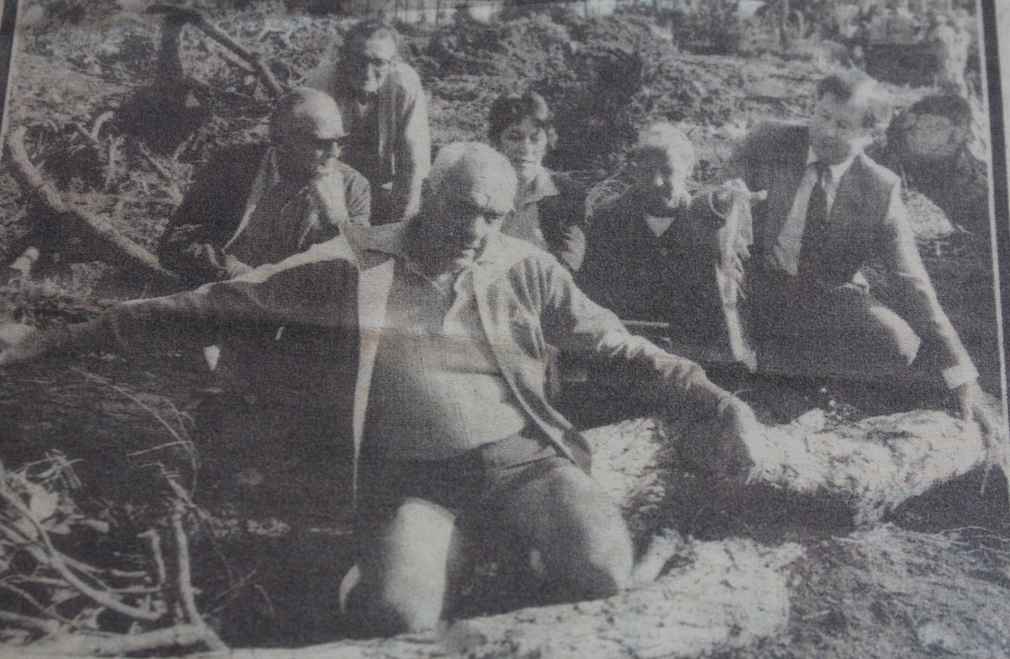
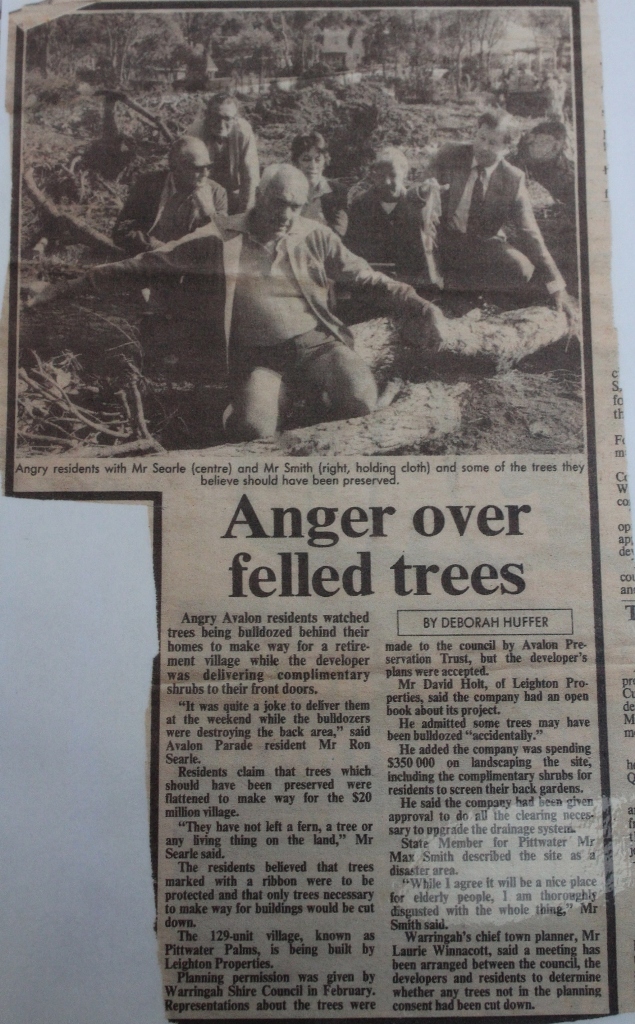
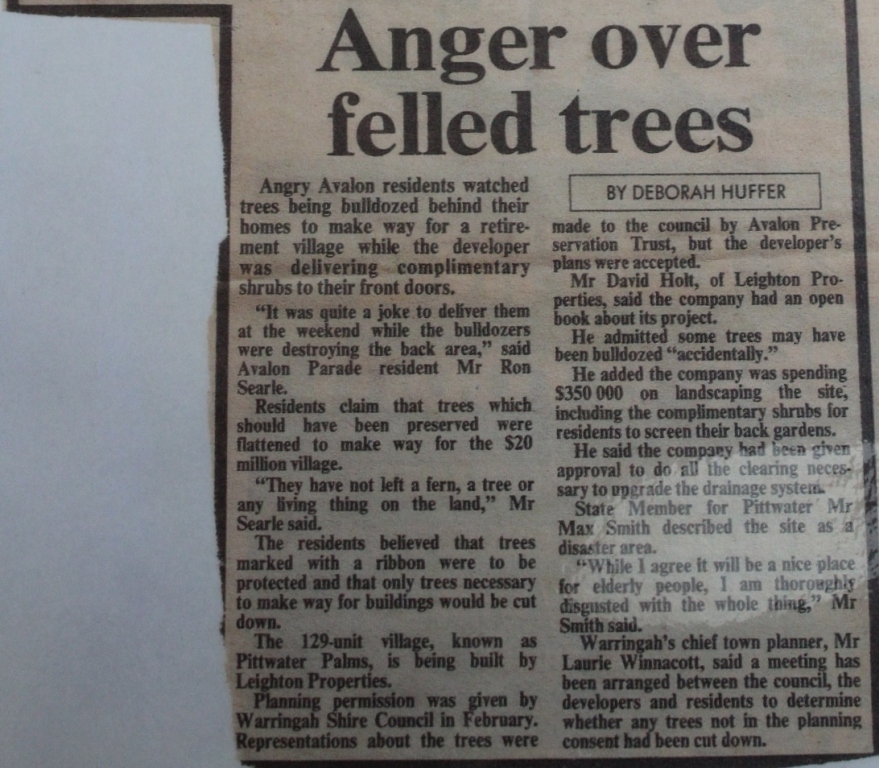
'The Koala population in Warringah Shire has declined over the last 50 years with increasing urbanization. Koalas were reported from various localities throughout the Shire in the 1940's, 1950's and 1960's. They now occur only at Barrenjoey Peninsula. Ku-ring-gai Chase National Park and, possibly, Davidson Park State Recreation Area. The colonies at Barrenjoey Peninsula and Ku-ring-gai Chase National Park have both declined in numbers and distribution since the 1970's. On Barrenjoey Peninsula, the main subject of this study, clearing for residential development has steadily reduced the area of forested land from about 705 ha (47% of the Peninsula north of Bungan Beach) in 1946 to about 125 ha (8%) in 1989. The Koala colony on the Peninsula has declined from an estimated 123+ Koalas in 1970 to only about eight Koalas in 1989.
The remaining Koalas appear to use several Council bushland reserves as refuges: Angophora Reserve/Hudson Park, Stapleton Park, Careel Headland Reserve, Crown of Newport Reserve and, until 1988, Algona Reserve. The principal food tree on Barrenjoey Peninsula is Grey Gum, Eucalyptus punctata. Other important food trees are Scribbly Gum, E. haemastoma, and Swamp Mahogany, E robusta. These food trees occur in low densities in the reserves compared with their former densities elsewhere on the Peninsula. The reserves have also suffered extensive eucalypt dieback associated with urban runoff, and their eucalypt communities are threatened by expansion of rainforest vegetation and Black She-oak, Allocasuarina littoralis, scrub.
The chief threats to continued survival of the Peninsula's Koala colony are further loss of habitat, within as well as outside reserves, and further mortality from dogs, motor vehicles and the disease chlamydiosis. The limited information available suggests that dogs have been the chief cause of mortality on the Peninsula, in contrast to other urban colonies studied, where it has been motor vehicles and chlamydiosis. The incidence of chlamydiosis has been low but may pose a particular threat to the few remaining Koalas. The history of Koalas on Barrenjoey Peninsula illustrates how a carefully planned and managed reserve system is crucial for Koala conservation in urban areas. This must be established in the early stages of regional development The deficiencies of the reserve system on Barrenjoey Peninsula pose enormous difficulties for rehabilitation of the Koala colony now.'
- An independent economic and social assessment which will consider the impacts on local jobs and communities
- The establishment of industry, community and Aboriginal advisory panels to provide input to the creation of the park
- An expert environmental and cultural heritage assessment to safeguard the unique environmental and cultural heritage of the region and ensure the Great Koala National Park aligns with the highest standards of environmental protection and respect for cultural heritage.
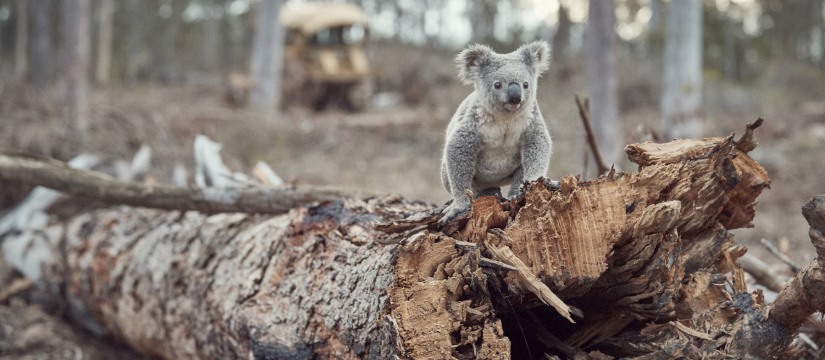
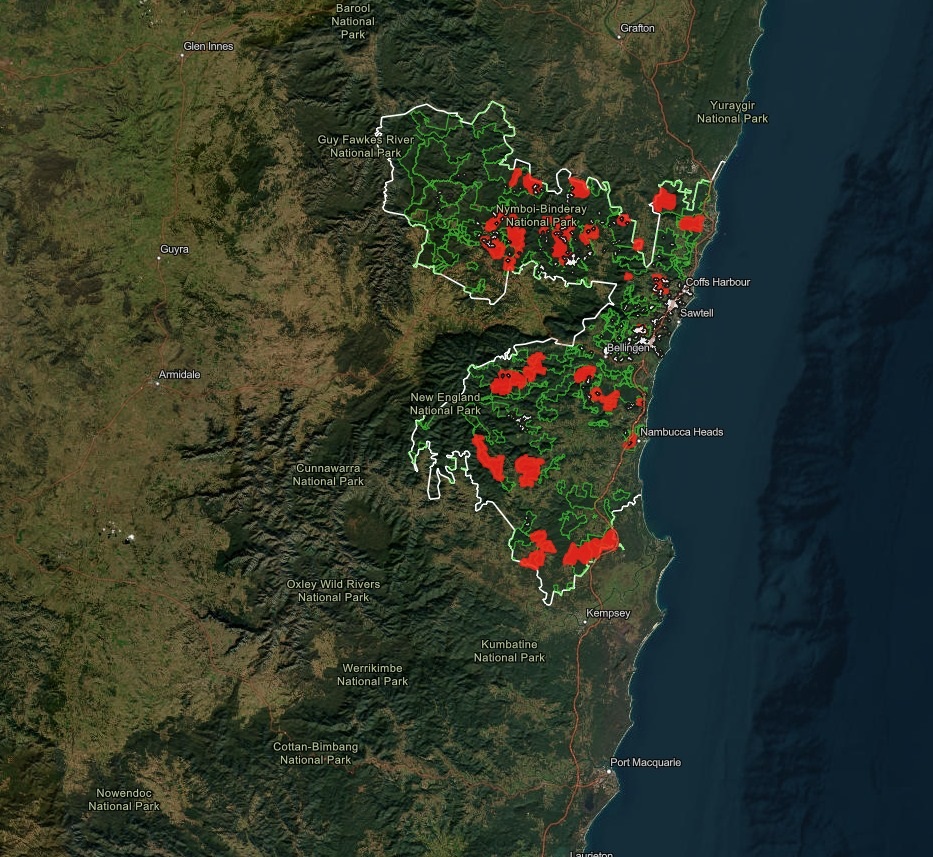
Case Study: Transport for NSW commissioned EMM Consulting and Lendlease to prepare an Addendum Report on the Environmental Factors for the Appin Road upgrade.Recently, Transport for NSW (TfNSW) appointed EMM Consulting Pty Ltd and Lendlease Communities (Figtree Hill) Pty Limited to prepare the Addendum Report on the Environmental Factors (November 2022) (Addendum REF) for the proposed staged upgrade of a 5.4 km section of Appin Road between Mount Gilead in the south and the intersection with St Johns Road, Ambarvale to the north, “which includes intersection upgrades, widening part of the road from two to four lanes and the construction of new intersections for access to the proposed (and approved) Mount Gilead residential subdivision.”Lendlease, the developer of the Mount Gilead housing estate, has now agreed to fund the inclusion of two fauna crossings under Appin Road and fauna fencing on the eastern side of Appin Road, thus necessitating the need for an Addendum REF.In SSK’s opinion, the Addendum REF highlights how a perceived conflict of interest has led to the design of suboptimal wildlife underpasses and inadequate analysis of the environmental impacts, as illustrated by the following facts and observations:● The main beneficiary of the Appin Road upgrade, Lendlease, was allowed to commission the Addendum REF on behalf of TfNSW. Enquiries about the Addendum REF were also directed to a Lendlease email address.● Findings made in the Addendum REF are not in line with previous advice to Government from the Office of the Chief Scientist and Engineer's Koala Expert Panel.The Addendum REF says, for example, that the impacts of the proposal have now been assessed as ‘not significant’ under both State and Commonwealth assessment criteria due to its limited impacts and the size and wide distribution of the local koala population."This claim is in direct contradiction to the Office of Chief Scientist and Engineer’s Advice on the protection of the Campbelltown Koala population Koala Independent Expert Panel 30 April 2020, (OCSE First Koala Report), which clearly emphasised how essential the existence of native bushland and rural farmland in the immediate Campbelltown area has been crucial for ensuring that the Campbelltown Koala population can expand its numbers and reach:
The Macarthur region is host to a historically continuous population of koalas, known as the Campbelltown population. The population of between 250 and 500 individuals is surviving in a landscape that is predominantly native bushland that is connected to rural farmland or peri-urban environment in the vicinity of the Greater Macarthur area.
The claim is also not in line with Addendum REF’s acknowledgment of the high level of Koala roadkill on the section of Appin Road to be upgraded:
The Department of Planning and Environment’s (DPE's) flora and fauna database, Bionet, holds records for 31 koala strikes on the section of Appin Road between Rosemeadow and Appin Township between 2010 and 2021 (Data downloaded August 2021). This figure would underestimate actual koala vehicle strikes as not all incidents would be reported. The modification of the Project REF is being proposed following confirmation of the State Government’s position on fauna corridors as part of the NSW Chief Scientist’s advice (Advice on the protection of the Campbelltown Koala population, Koala Independent Expert Panel, 20 April 2020) and later update to Greater Macarthur 2040.
● The Addendum REF also includes outdated information on the threatened species status of the Koala under both state and federal legislation.The Addendum REF includes a report by Eco Logical, Biodiversity Assessment for Appin Road Upgrade Review of Environmental Factors, which says that the “Koala is not an endangered ecological community." As a consequence, this report argues that the requirement to assess adverse effects on the risk of extinction to the local Koala population is not applicable.
At the outset, we were surprised by the lack of objectivity evidenced in this report, asserting as it does that in the absence of development, both the amount and quality of koala habitat in the Gilead area will deteriorate, which is not necessarily the case. The assumption that trees planted across the Gilead Stage 2 landscape will become a viable food resource for koalas at 4 - 7 years post planting is also fundamental to calculations relating to koala carrying capacity of the site both during and post development, but this critical milestone is not demonstrably possible for reasons we argue in the following paragraphs. (Campbelltown City Council, Agenda, 13 October 2020, page 63)
''Over 20 koalas have died on Appin Road this year—there were another three yesterday—together with countless wallabies, wombats, possums, gliders, snakes, lizards and birds. I've lost count of the number of times I've stood in this parliament and spoken about the need to protect Macarthur's koala colony and the need for sensible development to provide urgent safety upgrades to Appin Road for motorists and wildlife alike. In the last 20 years, over 20 people have been killed on Appin Road in motor vehicle accidents. I've lost count of the number of representations I've made to the state ministers, particularly those responsible for the environment, planning and transport, calling on them to take urgent action. I've been campaigning on this for eight years. To say I'm disappointed would be an understatement. Macarthur residents are beyond tired and frustrated with the lack of wildlife protections and road safety upgrades for Appin Road.''''In July, the New South Wales government, through the planning minister, gave conditional approval for a massive housing development to go ahead in Appin, which will displace countless wild animals and place unimaginable strain on local infrastructure. This project is, rightly, under the spotlight, as noted in today's Guardian, which shows that the former head of New South Wales planning approved this project before then taking up a job with the developer managing the project. Yet, while they found time to review and approve such a complicated project and look after themselves, they have not found time to approve and implement the upgrades and infrastructure that are so sorely needed to account for this monstrous project, a project that the New South Wales planning department noted would not be needed until 2036. Amidst all this, local wildlife advocates such as Ricardo Lonza, Pat and Barry Durham, Sue Gay and many others, have worked tirelessly helping injured and killed koalas along Appin Road, with many of these deaths and injuries occurring in the vicinity of this project. They are the unsung heroes.''There appears to be, however, a tacit agreement between the local council and the state government Department of Planning and Environment for extinction of our local koalas and continued environmental degradation. This is shameful. It is disgraceful. As I said, I've been informed that three koalas died yesterday on Appin Road. This week, the ABC published a harrowing story which stated that the New South Wales government has not collected important wildlife rescue data and wildlife mortality data since mid-2019, which has severely hampered the case against overdevelopment in these regions. This is outrageous and shockingly pathetic from government departments.I have called for a royal commission into planning and development in New South Wales. Nothing will satisfy me until this is implemented. I also call for urgent wildlife protections on Appin Road and human protections along Appin Road. If this necessitates a continued police presence along Appin Road 24 hours a day then so be it. This is a situation that would not be accepted in any other part of the country. It is an absolute disgrace that the people of South-Western Sydney have been ignored by governments for far too long. It is unacceptable that this situation is occurring, and it's severely affecting the quality of life for local residents and the local traffic mortality statistics in the area. It's affecting all those who are buying new developments in the area, and it has to stop.I have met with countless state ministers over a number of governments now, and no action has been taken. I am sick of the obfuscation, I'm sick of the lies and I'm sick of the lack of interest in the people and the wildlife of south-western Sydney. I demand that action be taken to investigate this. There is nothing further, I repeat, that will satisfy me.We are in a crisis situation. Koala extinction, and extinction of other wildlife, is happening in front of our eyes. I have called for a twin rivers national park to protect the environment. I have called for protections on Appin Road and for the widening of Appin Road. And yet nothing has been done. The lies have to stop. The diversions have to stop. Action is urgent.''
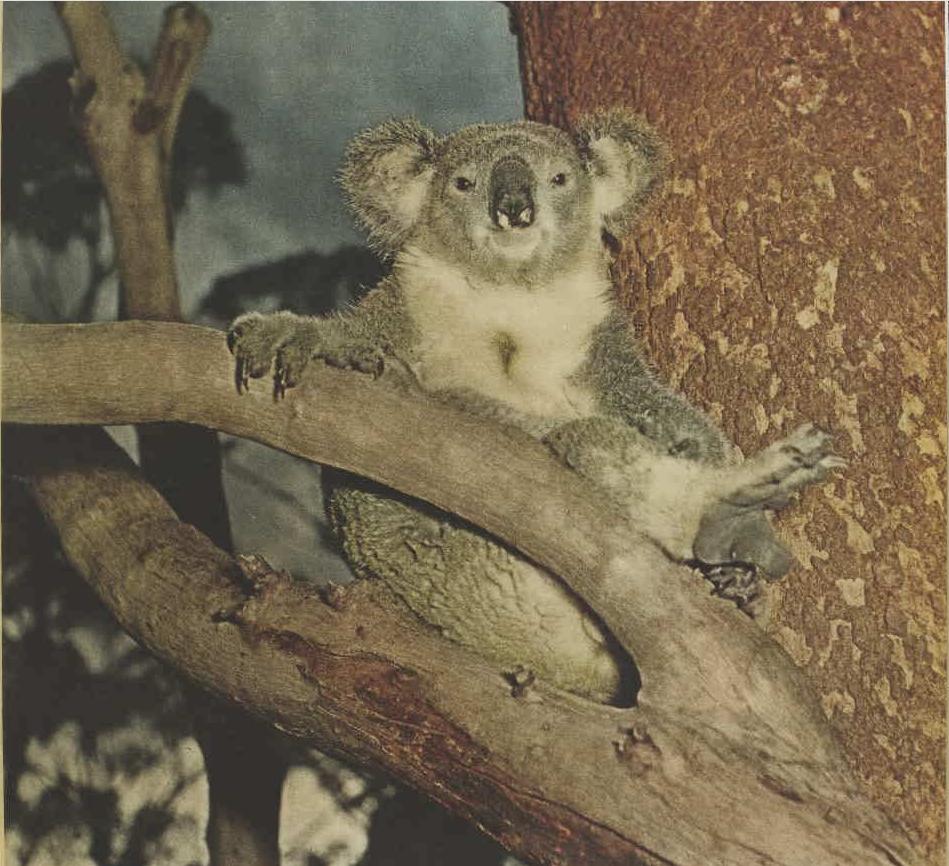
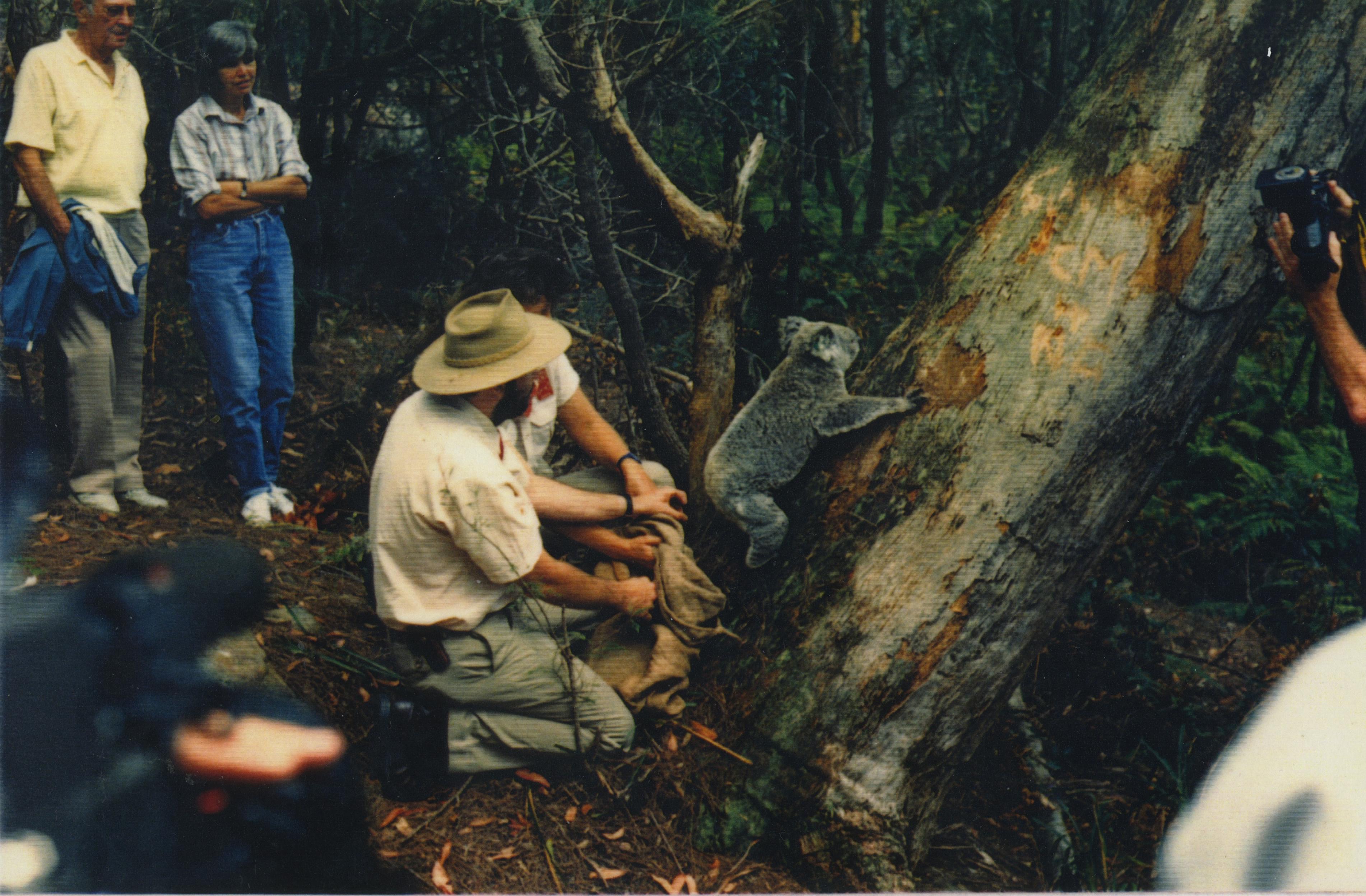
The release of an 8 years old female back into Angophora Reserve after she had been bombarded by magpies. Taronga Zoo picked her up and nursed her back to health before the release on November 5th, 1989. Doug Bladen and Marita Macrae are in the background representing the Avalon Preservation Trust (now APA). Photo by Geoff Searl OAM
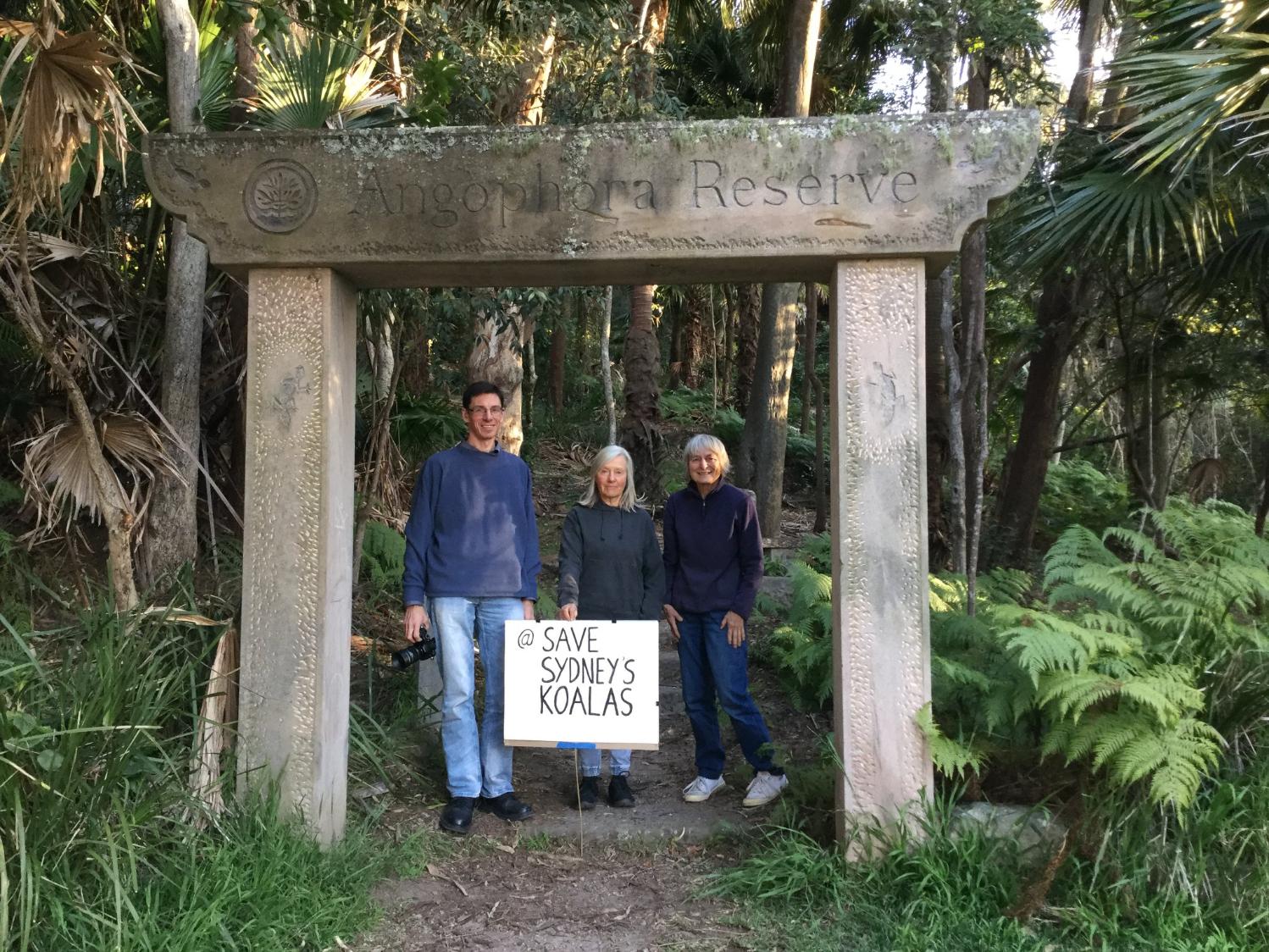
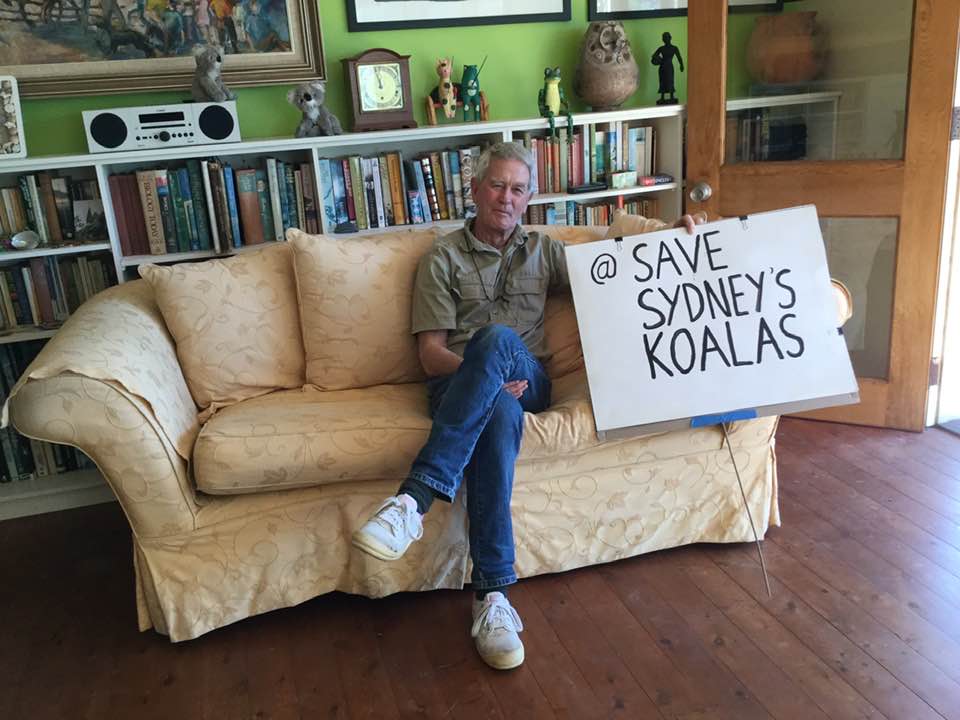
John Illingsworth - photos supplied.
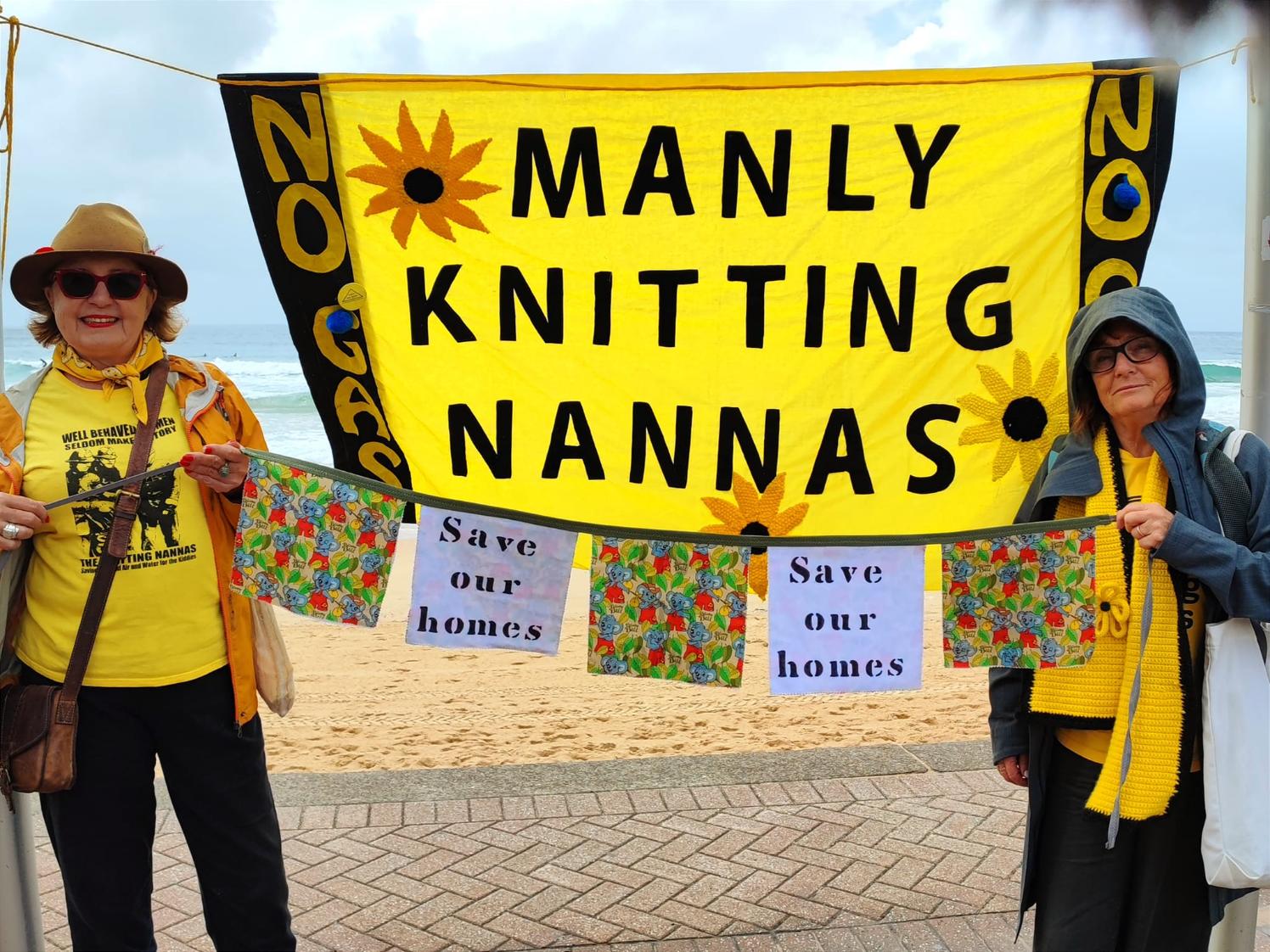
References - Extras
- Local MP's Call For Halt On Habitat Logging In State Forests: Logging Continues Within So-Called 'Great Koala Park' - 20% To Be Destroyed Before Koala Park Even Established Under RFA's That Run Until 2048 In NSW, Meanwhile, More Habitat Of Last Population Of Sydney Koalas To Be Razed For Profit
Invitation For Public Comment: Mt Gilead Stage 2 Residential Development, Gilead, NSW (EPBC 2019/8587) - Removing 46 Ha Of Koala Habitat & 'Offsets' For Other Critically Endangered Species
- Click here to download – EPBC 2019_8587 Mt Gilead Stage 2 Preliminary Documentation_AdequacyAssessment_Ver 3_20230720
- Click here to download – Appendix A_2019-8587 Referral
- Click here to download – Appendix B_EPBC 2019_8587 Decision notice 24FEB2020
- Click here to download – Appendix C_EPBC 2019_8587 PD Requirements_24FEB2020
- Click here to download – Appendix E_Lendlease SustainabilityPolicy
- Click here to download – Appendix F_cam-sustainability-framework-full-1
- Click here to download – Appendix G_ Australia-mission-zero-roadmap-summary
- Click here to download – Appendix H_MtGilead Stage2_Biocert_v8_20230718
- Click here to download – Appendix I_Draft Response Principles for Koala Protection in the Greater Macarthur and Wilton Growth Areas
- Click here to download – Appendix J_DPE Methodology to calculate Koala corridor widths
- Click here to download – Appendix K1_DPE Letter to Lendlease re Koala corridors – Dec 2021
- Click here to download – Appendix K2_DPE Indicative koala corridor map Gilead
- Click here to download – Appendix L_Koala_Conservation_at_Gilead_Lendlease 2022
- Click here to download – Appendix M_ Mount Gilead Stage 2 Koala Plan of Mgnt v4_20230720
- Click here to download – Appendix N_Mount Gilead Stage 2 EPBC CEMP V5_20230720_signed
- Click here to download – Appendix O – PMST Search – 2 February 2023
- Click here to download – Appendix P_EPBC Likelihood tables_v3-02022023
- Click here to download – Appendix Q_Koala Drone surveys Figtree Hill_Wild Conservation 2021
- Click here to download – Appendix R_Koala Drone Surveys Figtree Hill_Wild Conservation 2022
- Click here to download – Appendix S_PlotData_EPBCondition_20191009
- Click here to download – Appendix T_Flora Species List from plot data
- Click here to download – Appendix U_Naturalised Stormwater Strategy for Gilead_E2 Designs
- Click here to download – Appendix V_BioBankingCreditSummaryReport_Development_20230626
- Click here to download – Appendix W_BioBankingCreditSummaryReport_BiobankSite_20230626
- Click here to download – Gilead EPBC offset_CPW Step 1_Cond C_Ver 3_20230628
- Click here to download – Gilead EPBC offset_CPW Step 2_Cond A_Ver 3_20230628
- Click here to download – Gilead EPBC Offset_GHFF_Large-eared Pied Bat Offset Calculations_existing_Ver 3_20230628
- Click here to download – Gilead EPBC Offset_GHFF_Large-eared Pied Bat Offset Calculations_restored_Ver 3_20230628
- Click here to download – Gilead EPBC offset_Pomaderris_Vul_Ver 3_20220628
- Click here to download – Gilead EPBC offset_RFEF Step 1_Cond C_Ver 2_10112022
- Click here to download – Gilead EPBC offset_SSTF Step 1_ Cond A_Ver 3_20230628
- Click here to download – Gilead EPBC offset_SSTF Step 2_ Cond B_Ver 3_20230628
- Click here to download – Gilead EPBC offset_SSTF Step 3_Cond D_Ver 3_20230628
- Click here to download – Gilead_Koala Offset Calculations_Endangered_existing_Ver 3_20230628
- Click here to download – Gilead_Koala Offset Calculations_Endangered_restored_Ver 3_20230628
- Click here to download – Gilead_Koala Offset Calculations_Vulnerable_existing_Ver 3_20230628
- Click here to download – Gilead_Koala Offset Calculations_Vulnerable_restored_Ver 3_20230628
- Click here to download – Gilead_Quoll Offset Calculations_Vulnerable_existing_Ver 3_20230628
- Click here to download – Gilead_Quoll Offset Calculations_Vulnerable_restored_Ver 3_20230628
- Click here to download – Gilead_Quoll Offset Calculations_Vulnerable_Ver 2_10112022
- Click here to download – Gilead_Swift Parrot Offset Calculations_existing_CE_Ver 3_20230628
- Click here to download – Gilead_Swift Parrot Offset Calculations_restored_CE_Ver 3_20230628
Previous Reports:
- Bayview Koala Sanctuary - August 2012 History page
- Saving Ballina’s Koalas – Will Pittwater’s Mistakes Be Repeated? - March 2015
- Community Calls On Government To Put Koalas Before Developers For Once - June 2016; Mt. Gilead, Appin Road losses
- These Two Koalas Lost Their Mothers To Deforestation - November 2018 + Greater Macarthur 2040 Plan
- Mount Gilead Development Bulldozing Koala Habitat Approved: Resident Turtles To Go Too - The Beginning Of The End Of Campbelltown's Koalas - July 2019
- Summer Creature Features; Koala - Treed - 2012
- Saving Ballina’s Koalas – Will Pittwater’s Mistakes Be Repeated? - March 2015
- Koala Plans Receive Federal Government Approval - Ballina Highway; Update deliberate Destruction of Koalas Chosen - August 2016
- More Than 2.2 Million Hectares Of NSW Koala Habitat Could Be Cleared - October 2016 Pittwater Online Environment News
- Koala Sighted In Kosciuszko National Park for first time in 70 years - December 2016 Pittwater Online Environment News
- Australia: Place Of The Culling Fields, Koala Skins for Profit - August 2017
- Pacific Highway Koala Holocaust: Koala habitat destroyed - October 2017
- Koalas Now Safer Thanks To New Pacific Highway Signs - Ballina Highway upgrade: 110 hectares of koala food trees planted, now they only have to NOT be hungry while they grow - February 2018
- Environment Groups Call On Premier To Halt Logging In Core Koala Habitat; Gladstone State Forest, near Bellingen - February 2018
- Berejiklian Government Allows Open Slather On Wildlife - March 2018
- Old Growth Forest Under Attack As NSW Government Winds Back Environmental Protections - May 2018
- New Analysis Shows Government’s Koala Reserve System Offers The Species Virtually No New Protection - June 2018 Pittwater Online Environment News
- Community Calls On Government To Put Koalas Before Developers For Once - Mount Gilead Development - June 2018
- Destructive Logging Laws Slammed By Government Scientists; 99% of koala habitat at risk from clearing - November 2018 Pittwater Environment News
- These Two Koalas Lost Their Mothers To Deforestation - December 2018 Pittwater Online Environment News
- As The Dust Of The Election Settles, Australia’s Wildlife Still Needs A Pathway For Recovery - May 2019
- A Report Claims Koalas Are ‘Functionally Extinct’ – But What Does That Mean? - May 2019
- Mount Gilead Development Bulldozing Koala Habitat Approved: Resident Turtles To Go Too - The Beginning Of The End Of Campbelltown's Koalas - July 2019 - Pittwater Online Environment News
- Fires Last Straw For Koalas: Extinction Now Imminent Unless You Speak Up - November 2019
- School Strike 4 Climate At Narrabeen: December 13, 2019 - Bushfires - wildlife deaths
- Call For Pittwater Support To Save Sydney's Koalas - August 2020
- Our Koalas Need A Win! - August 2020
- Good News For Koalas This Week From NSW Government: The New Guula Ngurra National Park Has Been Proclaimed + The Cumberland Plain Conservation Plan Is Now Open For Feedback - August 2020
- Koala Extinction In NSW: The Facts And Directions For Action - Community Forum At Warriewood - March 2021
- Pittwater Action To Save Koalas: What You Can Do To Help Prevent Their Extinction - April 2021
- Sydney's Last Koala Population Being Killed As Mount Gilead Development Cuts Down Trees With No Fauna Passes Or Protections In Place: Pittwater Demonstration Falls On Deaf Ears - December 2021 to January 2022
- Koalas Now Listed As Endangered In NSW - Qld - ACT - February 2022
- Finalised Cumberland Plain Plan Released: 'A Developers Plan That Will Facilitate Extinction Of Sydney's Koalas' Locals State - A 'Tree Museum Plan' For Critically Endangered Woodplain - August 2022
- Residents Rally For Koalas At Manly On Save The Koala Day: Calls To Prioritise Wildlife, Stop Clearing Habitat - October 2022
- NSW Government 'Fast-Tracks' Destruction Of Endangered Wildlife, Habitat For Local Species and Community Consultation On Massive New Developments - November 2022
NSW Labor - Independents Commit To Serious Koala Protection: Candidate For Manly Visits Forests-Candidate For Pittwater States We Must Save Habitat
Friday January 20, 2023
Key independent MPs and candidates took to NSW State Forests today to shine a light on the need for forest protection ahead of the upcoming New South Wales election.
MPs Justin Field (MLC) and Sue Higginson (MLC) were joined by candidates Joeline Hackman (Independent for Manly), Karen Freyer (Independent for Vaucluse) and Liza Butler (Labor - South Coast) on a visit to native state forests which are earmarked for logging.
The tour included logged and unlogged parts of the biodiversity rich Boyne, Benandarah and Brooman state forests, which are home to large populations of endangered species including the swift parrot and the southern greater and yellow-bellied gliders.
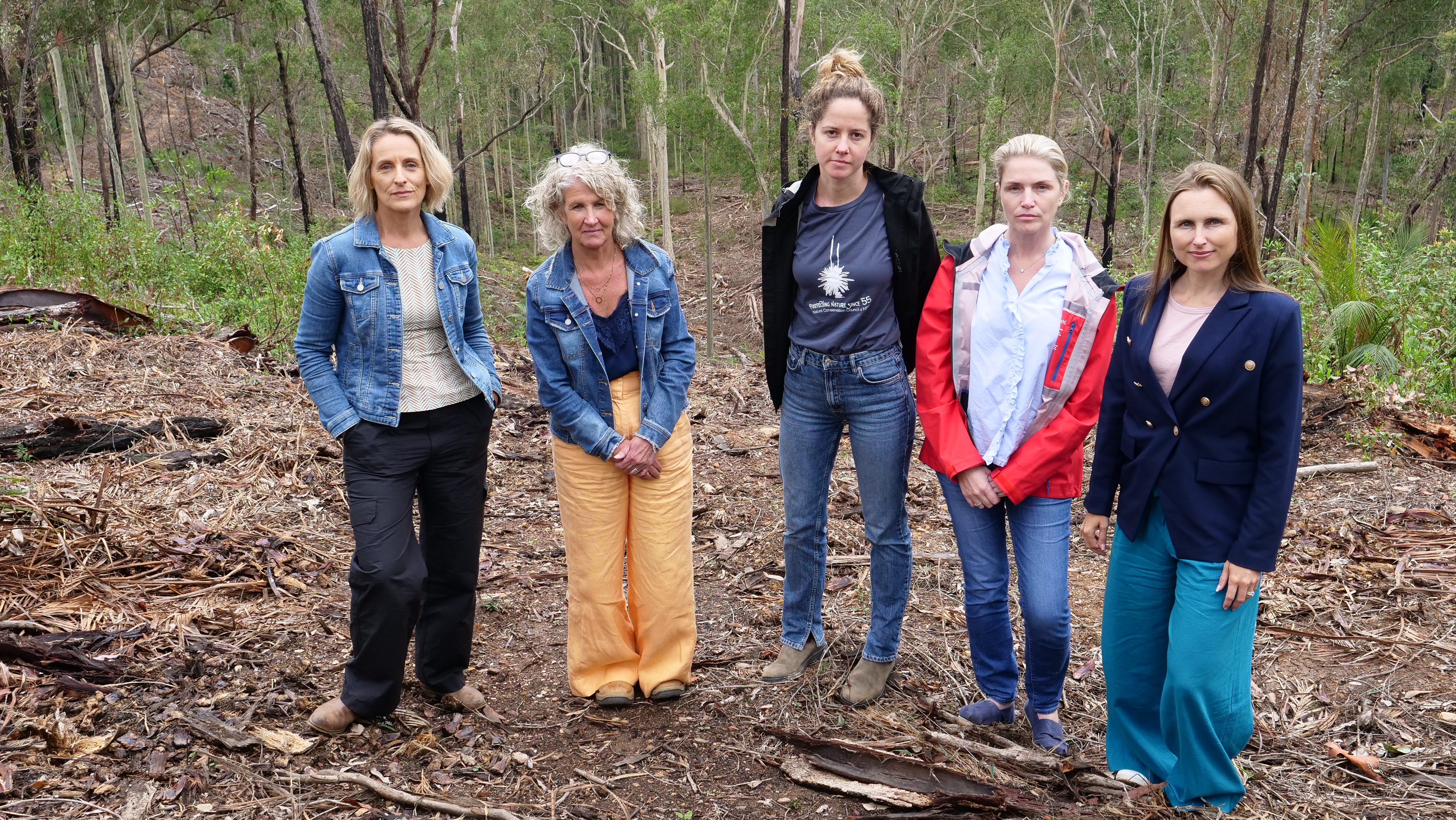
(From L to R) Sue Higginson, Liza Buttler, Jacqui Mumford, Karen Freyer and Joeline Hackman in Benandarah Compartment 109. Photo supplied
The field trip was organised by the Nature Conservation Council of NSW to draw attention to the 14,000 hectares of incredible native state forest which are destroyed each year by government approved logging.
NCC Chief Executive Jacqui Mumford says forest protection will be a defining issue at the election on March 25.
“Voters want an end to native forest logging. They don't want to live in a state where iconic wildlife like the koala and the Gang-Gang Cockatoo are driven to extinction by political inaction.
“Nor is there any economic argument to continue native forest logging, given plantation forests already provide 90% of New South Wales timber production.”
Manly independent Joeline Hackman says the major parties are on notice not to ignore the wishes of voters.
“What we saw today in the great forests of the South Coast are areas of outstanding environmental value.
“No matter where people live in New South Wales, they want these beautiful forests preserved for generations to come,” said Ms Hackman.
Independent candidate for Pittwater Jacqui Scruby has voiced her opposition to the continued destruction of wildlife habitat since announcing her bid for the local seat.
Vaucluse independent Karen Freyer says today’s visit reinforced the urgent need to protect our ancient native forests.
“The community cares deeply about the destruction of forests and the clearing of important koala habitat.
“If we learned one thing from last year’s federal election, it's that voters are sick and tired of being taken for granted. They want an end to logging and a much better deal for our precious wildlife.
“We have no more time to waste,” said Ms Freyer.
The Nature Conservation Council of NSW, the state’s peak environment organisation, has also welcomed Labor’s Plan to Save Koalas, announced on Thursday January 19th.
''After 12 years and six environment Ministers this Government has overseen the decimation of our Koala population.
We will take the action needed to turn this grim trajectory around, creating a Great Koala National Park that will home 20% of our state's koalas, while also protecting the places koalas live, and working closely with all stakeholders to ensure we bring these incredible creatures back from the brink.'' NSW Labor leader Chris Minns stated
NCC Chief Executive Jacqui Mumford says the plan represents serious and overdue action to address the most pressing threat facing koalas in our state.
“Loss of habitat is the number one reason koalas are being driven towards extinction in NSW.
“This plan is what koalas need, because it contains concrete actions to address that threat.”
The NCC is demanding the Coalition match Labor’s commitments, namely the establishment of the Great Koala National Park and reigning in excessive land clearing.
“Treasurer Matt Kean said he would double koala populations, yet koala habitat continues to be logged and cleared at a terrible rate, says Ms Mumford.
“Labor and independent candidates are presenting strong environmental commitments to voters, so the Coalition can’t afford to take a koala policy written by the Nationals to this election.”
Nature Conservation Council is calling on all parties to deliver:
- An end to native forest logging and transition to a 100% plantation-based timber industry, and
- Assessment, mapping, and protection of koala habitat across the state on public and private land.
The announcements on Friday came the same day community group Save Sydney's Koalas were notified NSW Planning Minister Anthony Roberts had responded to their petition, signed by over 20 thousand NSW residents.
''The NSW Government has issued a response to our 20,000+ E Petition. We note that they did not allow time for it to be debated in the NSW Parliament.
They are not saving the Koalas of south west Sydney.
They are not following the advice of the NSW Chief Scientist but instead have watered it down to a meaningless form. Instead of 6 east west corridors there will be just one or two, neither will be 350 metre wide minimum, despite him being able to rezone to deliver the widths.
Anthony Roberts disinterest is reflected in the opening paragraph where he states that Koalas are Vulnerable in NSW. Koalas have been listed as Endangered in NSW since February 11th 2022.'' a spokesperson for the group states.
''We have had to fight for any improvements to corridor number, widths, undercrossings on Appin Rd - its been relentless for us and we are grateful for the wide public support we ( the Koala) receives as we continue to advocate for habitat.
This picture is perhaps the easiest way for people to see what is going to happen in south west Sydney, this is the critical east west wildlife corridor between the Georges and Nepean Rivers at Mount Gilead also known as the Lendlease development.
Developers include the NSW Government, Landcom at Airds cutting the Smiths Creek corridor, Walkers at Appin, Inghams at Tahmoor and Appin, Country Gardens at Wilton etc. etc.
This is just the beginning of the land clearing and habitat loss the Koala and over 278 Threatened Species will face in areas such Campbelltown, Appin, Liverpool, Wilton.
It is not too late but clear that the NSW Government has failed the Koala of SW Sydney, all the green towards the Blue Mountain will be cleared unless significant changes are made.''
Australian Ethical has echoed Saving Sydney's Koalas findings.
In December 2022 they stated ''Australian Ethical has been working hard behind the scenes to ensure that the native koala colony is not negatively impacted. But we’ve hit a roadblock. If Lendlease proceeds with the Mount Gilead Phase 2 development as currently proposed, we will sell our shareholdings in Lendlease.''
The $8 billion investment fund states;
''On 21 November 2022, the NSW Government exhibited plans for Phase 2 development as part of its public consultation, which closes on 19 December.
The NSW Government had foreshadowed that it would publish mapped koala corridors for the Gilead development, showing how the average widths were calculated, but it has failed to include this information as part of its public consultation. Without this key information, there is no way for Australian Ethical or conservation groups to assess with any confidence whether the corridors will allow koalas safe passage through the site.
The corridors are needed to ensure koalas have east to west connection across the site; and to ensure the Nepean River koala corridor does not become a functional dead end at Mount Gilead.
While our engagement with Lendlease to date has been largely constructive we continue to be concerned that the development will have a net negative impact on koalas.
Today (March 13, 2023), we have made a public statement calling on the NSW Government and Lendlease to be transparent about their calculations of the width of the koala corridors, to give AE and others the ability to take part in a genuine consultation on this important issue.
Our statement makes clear that unless this information is provided, we cannot have assurance that the koalas will be sufficiently protected. If Lendlease proceeds with the Mount Gilead Phase 2 development as currently proposed, we will sell our shareholdings in Lendlease.'
In reply Lendlease has stated, 'We have engaged with Australian Ethical over a number of years to share our plans for the project, which fully adhere to the independent and expert recommendations of the NSW Chief Scientist.
Our $35 million investment into conservation at Gilead includes creating koala corridors that have been independently assessed as meeting the recommendations of the Chief Scientist in terms of width and connectivity.
A map outlining the corridors has been published on the NSW Department of Planning and Environment’s website. In addition, the Department has published the scientific recommendations and policy that support these corridors, and the methodologies for how they are calculated and mapped.
Our conservation investment also includes plans to increase core koala habitat by 70 hectares – 30 per cent more than what’s there today. And it includes improving road safety on Appin Road, a known blackspot for koala fatalities.
Every conservation measure we have proposed is fully funded and follows the advice of the Chief Scientist’s panel of independent koala experts. By following this advice and investing in conservation, local koalas will have the best opportunity to thrive at Gilead. At no time during project delivery will there be less core koala habitat than there is today.
Australian Ethical’s inference that the public exhibition lacks transparency for koala corridor calculations is demonstrably incorrect given the extensive information that has been published.
The fragility of Australia’s biodiversity is an issue of national significance, and we are acutely aware of our ethical and environmental responsibilities. We remain steadfast in our plans to meet and where possible exceed all of the Chief Scientist’s recommendations for koala conservation as we help address the critical shortage of new and affordable homes in Sydney.
Lendlease recently responded to Australian Ethical’s concerns and our response can be viewed here. The NSW Department of Planning & Environment advice is publicly available here. The full documentation submitted with the rezoning proposal can be found at this website: https://pp.planningportal.nsw.gov.au/ppr/under-exhibition/gilead-stage-2 '
However, as many groups as well as individuals have pointed out, including Australian Ethical regarding this single development; 'The NSW government has confirmed that the corridors will meet the minimum requirements, but we do not think Government endorsement of Lendlease’s plans gives sufficient certainty. There is some ambiguity in how the Panel’s recommendations should be interpreted and applied. And successive governments have failed to prevent the decline of native species, including koalas.'
With so many others tabled by the current State Government as both proposer and approved, it is clear that thousands of hectares of habitat are slated for destruction, action that will kill all that lives there and calls these places 'home'.
More in previous reports:
- Finalised Cumberland Plain Plan Released: 'A Developers Plan That Will Facilitate Extinction Of Sydney's Koalas' Locals State - A 'Tree Museum Plan' For Critically Endangered Woodplain
- Residents Rally For Koalas At Manly On Save The Koala Day: Calls To Prioritise Wildlife, Stop Clearing Habitat
- NSW Reconstruction Authority Corporation Formally Announced - Has Powers To Acquire and Develop Land: Potential Local Implications
- Koalas Now Listed As Endangered In NSW - Qld - ACT
- Senior Liberal Party Member Catherine Cusack Crosses Floor To Save Koalas
Koala Spotted In Belrose Area
- dog attacks - please keep your pets away from wildlife
- vehicles - slow down for wildlife particularly on Wakehurst Parkway, Mona Vale Road and Forest Way
- habitat destruction - over development on the NB is a major threat to our koalas and could eventually wipe them out.
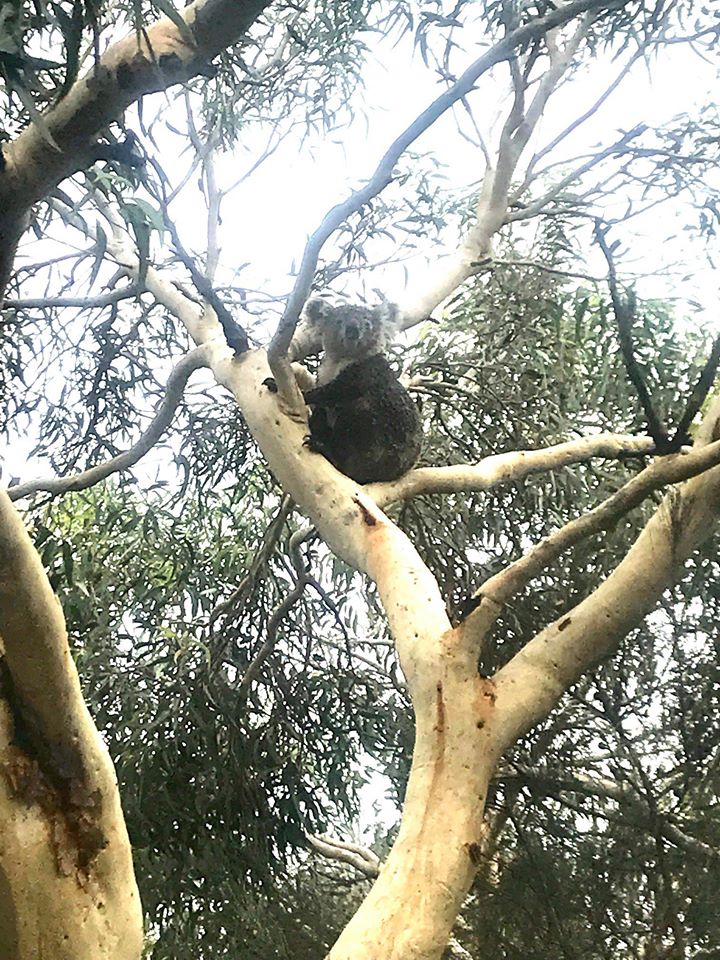

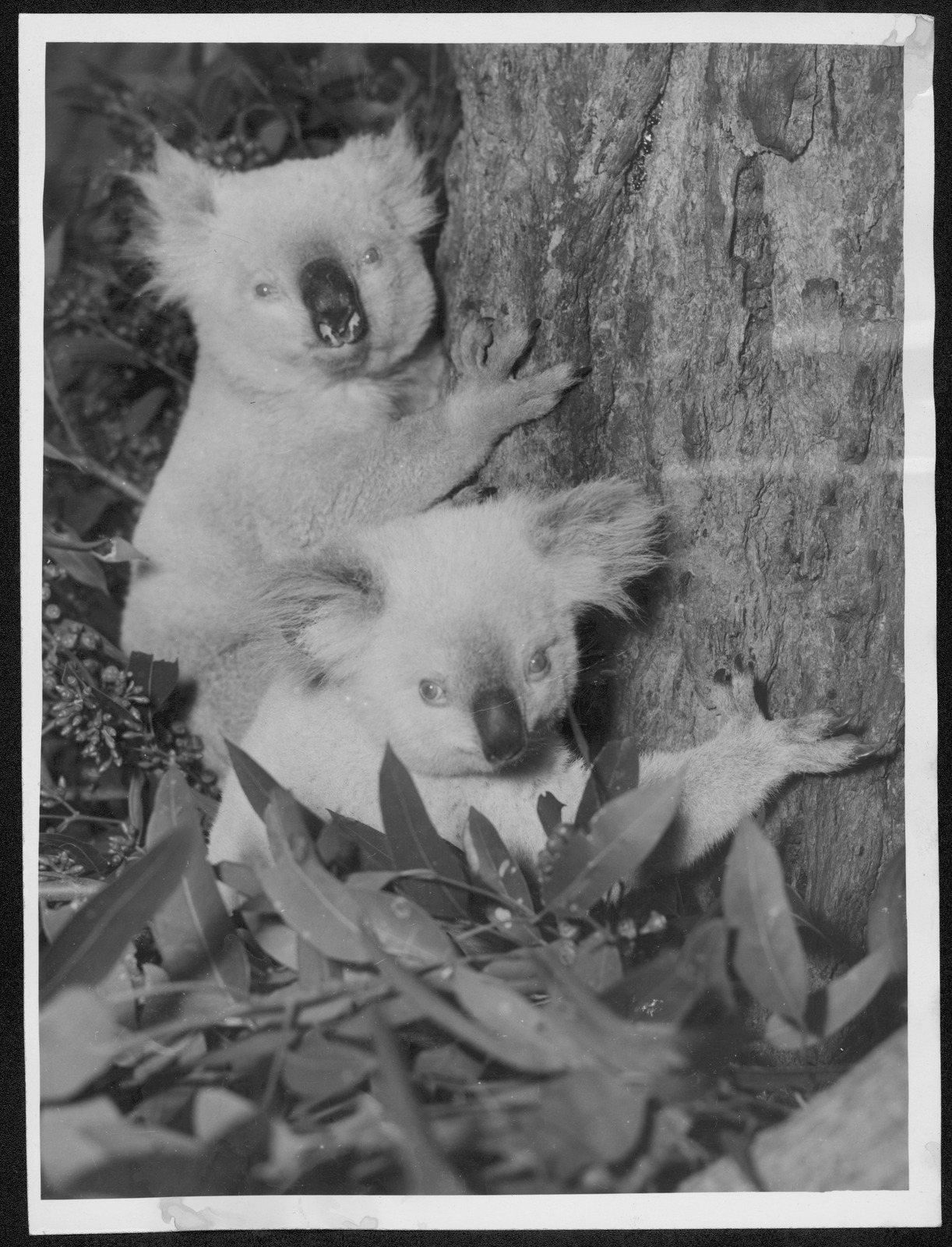
Two white koala bears [i.e. koalas] which Sir Edward Hallstrom has bred. [picture]. Sir Edward, of the Taronga Zoo Trust had taken almost six years to develop the pure white strain of koala. [ca. 1935] Argus Newspaper Collection of Photographs, courtesy State Library of Victoria. Date on reverse of photograph. More in Bayview Koala Sanctuary